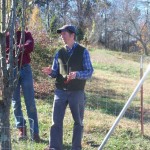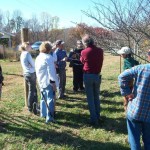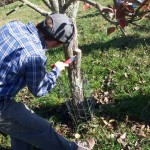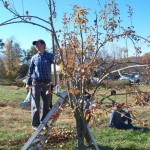Going Rogue
Saturday morning: With no warning the steer turned in open field and charged head on at Cindy and her horse. It hit her Morgan squarely in the chest, throwing her backwards. Cindy went flying, making a rough landing on her back and neck. Stiff and sore all week, she was reminded why she wears a helmet.
The young steer, just 425 pounds, turned and ran down the hill, leapt a fence and disappeared into the woods. Cindy returned to the barn and took off the saddle. I put away the tack and returned Oksana to the field. We left the steer behind, wherever he had gone.
The night before: We had bought him, along with four other steers, the previous day. The farmer 20 miles to the south, with a large acreage devoted to purebred Angus. The old man introduced himself as “the “M” in L&M Motors” (a local auto dealership). He had a dozen or so calves to select from for our needs. We bought five of similar weight. While loading, one steer was spinning around, in mad desperation trying to escape. We gave it little thought.
We hauled the trailer back to our farm, and I backed it up to the outer corral. The outer corral is fenced with barbed wire, while the inner corral is oak slats. Cindy hopped out of the truck and opened the gates and the door to the trailer. The steers ran out. I pulled away and parked the trailer.
We typically leave new livestock up for a few days to make sure they settle down and have no health issues before releasing them onto pasture. As we walked back out to inspect our new steers, Cindy said, “I thought we bought five.” In the 15 minutes it had taken to close the gates and park and unhook the trailer, one steer had leapt the fence and was nowhere to be seen.
After watering and feeding the steers, we spent a few fruitless hours looking for the steer. He was not to be found anywhere on the property, pastures or woods. If he didn’t show up it would be a heavy financial loss.
Saturday morning. The next morning when we headed out to feed, the calf had reappeared in the upper pasture with the older steers. Cindy saddled Oksana and went to move the partial herd down to the barn with the new steers. The older steers turned toward the barn. The young steer threw his head back and ran for the woods.
Cindy took followed on horseback moving the steer along the fence. Cue the aggressive turn and the aforementioned collision.
We have dealt with many frightened cattle before. But this was the first truly aggressive, belligerent and dangerous one. When he knocked Cindy off the horse, leapt the fence and disappeared, we wished him Godspeed to the next county. We went ahead and let the other steers out to join the primary herd.
Sunday morning. Sunday dawned and I did the morning chores, once again counting an extra steer in the herd on the hill. He’s back. Cindy wanted him gone from the property. I, not having witnessed the previous day’s assault, was inclined to let him settle down. After all, we had had wild livestock before that had grown docile.
Cindy was adamant. Later in the day I noticed a group of steers heading to the barn… The rogue steer was among them. We closed the gate to the inner corral. With Cindy at the gate, I began to move the other steers out. Cindy would swing the gate open and closed as needed. Meanwhile I kept a close eye on the crazy one. He was running wildly around the corral, head thrown back, tail swishing, looking for a way to escape. The other steers were docile and filed out, leaving him alone. I exited the inner corral.
Even though the wooden corral fence was high, we were both concerned he would go back over and once again take to the hills. So when he ran into the barn, I swung the gate closed quickly behind him. Snorting like a bull in the matador arena, he turned on a dime and charged full force at me, bouncing off the metal gate. I instantly became a believer: away with him to the stockyard.
But how to load the little bugger? We dropped a water trough over the gate and I began filling it. It only agitated him more, and he began to charge at everything in his vision–the floor-to-ceiling metal barn door, the walls, and the trough. I gave him some hay, thinking that might calm him down. He swished his tail, looked me in the eye and resumed the charge.
About this time friends arrived for dinner, on their way back from a sustainable farming conference in North Carolina, headed to their farm outside of Nashville. We showed them the rogue steer–he greeted them by climbing the walls.
Monday morning. Monday morning broke, Cindy went off to work, and I worked from home on the computer. As soon as Cindy got home, she called the stockyard in Athens. They were taking cattle until 8 in the evening for the Tuesday noon sale. I was still hoping the steer would magically disappear. She insisted we try to load him.
It took only a few minutes to hitch up the trailer and back it to the corral gate. By now it was dark. The steer thundered around in the barn. We turned the corral and barn lights on and began to set up the corral panels, interlocking 16-foot metal panels used to create a chute to drive docile animals into the trailer.
Nerve wracking it was to have him snorting and charging up the chute, and then back to the barn, only the panels separating us, but after about five runs, he finally ran into the trailer. Cindy, who had been in the barn, on the opposite side of a gate, waving her arms trying to move him out, sprinted to the trailer at my hoarse yelling of “HE’S IN, HE’S IN!” and slid the trailer door closed. Surprisingly, the whole operation went fairly smooth. We were both nonetheless sweating.
We made good time to the stockyard, ran the gauntlet of pin hookers. A pin hooker is an old-fashioned term for men who buy cattle at cut-rate prices. The name was given to Yankees after the Civil War who came down and preyed on a defeated country, offering low prices to people who had no other recourse but to sell. It is still used for people who buy and sell on the cheap. As I drove the trailer up to the gates, they gathered on both sides.
“What do you want him for him?” “What do think he will bring?” “I hear you, but what do you really want to get for him?” “Well, you won’t get that much. I’ll take him right now.” “What do you think he weighs, and how much per pound do you want? I’ll give you $200.”
Cindy and I resisted their not-so-enticing offers and put him in the auction for the following day. The check came in the mail on Friday, and we barely made back the money we’d put into him. Last night we walked up among our peaceful herd, grazing and paying us no mind.
As it should be….




